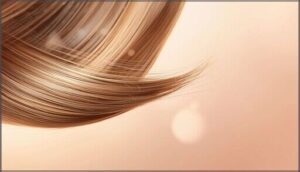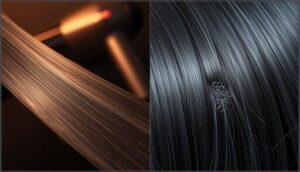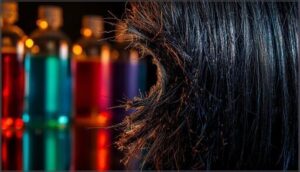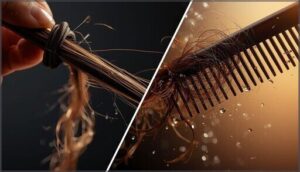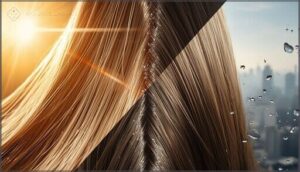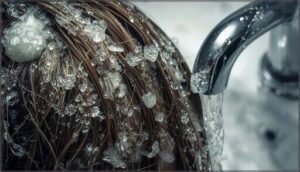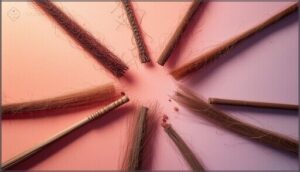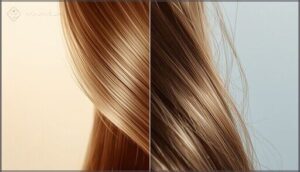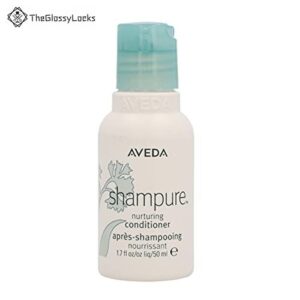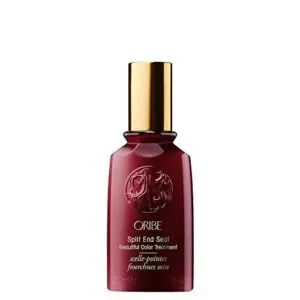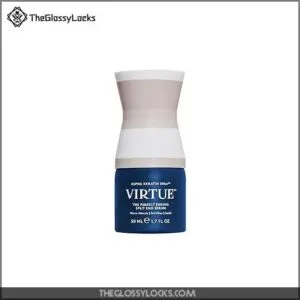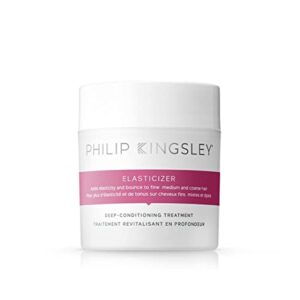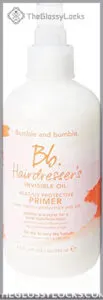This site is supported by our readers. We may earn a commission, at no cost to you, if you purchase through links.
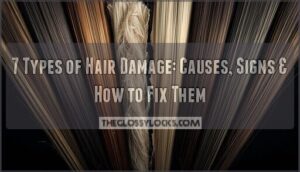
Three out of four people will deal with split ends at some point, but that’s just one player in a much larger lineup. Your hair faces a daily gauntlet—flat irons cranked past safe temperatures, bleach that rewrites its molecular structure, ponytails pulled tight enough to strain follicles, and UV rays that degrade strands like old fabric left in the sun.
Each assault leaves a different calling card: brittle ends that snap, frizz that defies gravity, or that telltale dullness that no amount of shine spray can fix. The frustrating part? Many people treat all damage the same way, wondering why their one-size-fits-all approach keeps failing.
Knowing which type you’re dealing with changes everything—from the products you reach for to the habits you need to break.
Table Of Contents
Key Takeaways
- There are seven main types of hair damage, each with different causes like heat, chemicals, rough handling, environmental exposure, hard water, and poor nutrition.
- Treating hair damage works best when you match your products and habits to the specific damage type, rather than relying on a one-size-fits-all approach.
- Signs of damage include dryness, frizz, split ends, loss of elasticity, and rough texture, which all signal your hair needs targeted care.
- While you can improve the look and strength of damaged hair, some damage—especially protein loss and cuticle breakdown—is permanent without trimming.
Common Types of Hair Damage
Not all hair damage looks the same, and understanding what you’re dealing with is the first step to fixing it. Each type has its own causes and warning signs, so knowing the difference helps you choose the right approach.
Let’s walk through the seven most common types of hair damage you might be seeing in your mirror.
Split Ends
Ever wonder why your hair keeps breaking at the tips? Split ends—technically called trichoptilosis—affect about 75% of people at some point. These splits happen when your hair’s protective outer layer breaks down, exposing the inner cortex.
They can appear as simple Y-shapes or feathery splits from chemical overuse.
Regular trims every 6-8 weeks and protein treatments help prevent this common hair damage. For those with color-treated hair, consider more frequent split end trimming.
Heat Styling Damage
Blow-dryers and flat irons might seem harmless, but heat styling damage happens faster than you think. When styling tools hit temperatures above 180°C (356°F)—which many do—they trigger cuticle disruption and can denature the keratin proteins inside your hair shaft. You’ll know you’ve overdone it when you spot bubble hair under a microscope, those tiny voids that form when steam gets trapped inside wet strands during high-heat passes.
Heat styling above 356°F denatures keratin and creates microscopic steam bubbles inside your hair shaft—damage happens faster than you think
High temperatures can also strip natural oils from the hair, leading to dryness.
Chemical Damage
Chemical damage goes deeper than heat. Hair coloring, bleach damage, perming risks, and relaxer issues all break down the disulfide bonds that give your hair its strength.
When more than 60% of adults dye their hair regularly, those chemical treatments add up fast. You’re looking at lifted cuticles, protein loss, and weakened strands that need serious bond repair to bounce back.
Mechanical Damage
Mechanical damage sneaks up through everyday habits. Rough combing—especially when hair’s wet—leads to hair breakage because strands are more vulnerable to snapping. Tight styles like braids and ponytails create constant tension that weakens hair elasticity over time. Even hair ties and accessories cause structural changes by putting pressure on the same spots.
The result? More breakage, less bounce, and hair that won’t cooperate no matter what hair damage solutions you try.
Environmental Damage
Your hair faces a daily assault from UV radiation, air pollution, tobacco smoke, and water chlorination—all creating oxidative stress that weakens strands. Sun damage breaks down proteins and fades color, while pollutants cling to your cuticle and make hair rough. Chlorine strips natural oils, and even secondhand smoke accelerates greying.
These environmental stressors combine forces, leaving hair dry, brittle, and vulnerable to breakage.
Hard Water Damage
If you’ve noticed your hair feels stiff, dull, or tangles more than usual, hard water might be the hidden culprit. About 85% of U.S. homes deal with elevated calcium and magnesium in their tap water, and those minerals build up on your strands—causing hair damage from hard water that’s harder to reverse than you’d think.
- Mineral buildup coats your cuticle, blocking moisture and making conditioner less effective
- Hair brittleness increases as calcium deposits stiffen fibers and weaken tensile strength
- Scalp issues worsen when shampoo can’t rinse cleanly, leaving residue that irritates skin
- Water softeners or chelating shampoos (with EDTA or citric acid) help remove stubborn deposits weekly
Nutritional Deficiency Damage
When your diet lacks key nutrients, your hair sends distress signals you can’t ignore. Protein deficiency, iron deficiency, and low vitamin D all trigger telogen effluvium—the medical term for excessive shedding.
Nearly half of women with thinning hair show low ferritin levels, while essential fatty acids control hair pigmentation and strength.
Nutritional deficiency damage affects hair health from the inside out, causing breakage, dullness, and even color changes that topical treatments can’t fix alone.
Causes Behind Each Hair Damage Type
Now that you know the types of damage your hair can face, let’s talk about what’s actually causing them. Each type of damage has specific culprits behind it—and once you understand what’s hurting your hair, you can stop it in its tracks.
Here’s what’s really going on.
Overuse of Heat Tools
Ever wonder why your flat iron seems to sabotage your hair? Heat styling tools damage hair when temperatures exceed 300°F, triggering protein degradation and irreversible cuticle damage. Your strands lose moisture at these heat thresholds, becoming brittle and porous.
Without heat protectant spray, you’re basically cooking your hair—and yes, scalp impacts include irritation and stunted growth. Daily heat styling? That’s a one-way ticket to breakage city.
Chemical Treatments and Dye
Think bleaching is just a color change? It’s actually stripping protein from your hair shaft—sometimes over 200% loss compared to untreated strands. Chemical treatments and dye work deep in your cortex, breaking down those disulfide bonds that give hair its strength.
- Bleach damage progressively weakens both cuticle and cortex layers
- Protein loss triples when you combine dye with relaxer effects
- Dye porosity increases moisture loss and accelerates color fading
- Chemical damage from hair coloring becomes irreversible without cutting
Harsh Hair Handling
You mightn’t realize it, but your daily routine is rough on your hair. Towel friction from vigorous rubbing roughens cuticles and triggers split ends—especially when you’re combing damage into wet strands. Tight styles like ponytails and braids create constant tension that leads to hair breakage and lost hair elasticity. Even gentle mechanical wear adds up over time.
Looser hair ties and air-drying can save your strands from mechanical damage before it’s too late.
Sun, Pollution, and Chlorine Exposure
Your hair’s facing invisible enemies every day. UV rays break down proteins and fade color—just 65% to 95% of your hair’s protein can be damaged by sun exposure. Air pollution particles cling to strands, while chlorine from pools strips natural oils and weakens bonds. Swimmers face the worst combo: greenish tints and brittle texture.
UV-protective sprays, chelating shampoos for chlorine damage, and even a simple hat offer real hair protection against environmental damage.
Poor Diet and Nutritional Gaps
While external enemies weaken your strands, what you’re not eating matters just as much. Protein deficiency, vitamin deficiencies, and mineral imbalance from restrictive diets or rapid weight loss sabotage hair health from within. Nearly half of women with hair loss show low iron stores, while vitamin D, biotin, and zinc gaps trigger thinning even when blood work looks “normal.”
Hair vitamins and hair minerals you’re missing:
- Iron and ferritin – Found in nearly half of shedding cases; deficiency starves follicles
- Vitamin D – Low levels strongly linked to female pattern loss and alopecia areata
- Biotin (vitamin B7) – 38% of women with hair complaints test deficient
- Zinc and copper – Trace element gaps slow growth even within “normal” lab ranges
- Protein (80–100g daily) – Crash diets and bariatric surgery create fragile, sparse strands
A balanced diet with adequate protein, essential fatty acids, and a quality multivitamin offering 200% daily values can reverse deficiency-driven damage within months.
Signs and Symptoms of Hair Damage
Your hair usually tells you when something’s wrong—you just need to know what to listen for. Damaged hair doesn’t always look the same, but there are a few telltale signs that show up again and again.
Here’s what to watch for when your hair’s trying to get your attention.
Dryness and Frizz
Ever wonder why your hair turns into a puffball on humid days? Hair frizz happens when moisture from the air invades your strands—especially if you’ve got high porosity levels from cuticle damage. Heat from blow-dryers and poor drying methods strip away protective layers, leaving your hair dry and vulnerable to humidity.
Hair moisture balance is crucial. When it’s off, frizz appears faster than you can say “bad hair day.” The solution lies in repairing damaged barriers to keep unwanted moisture out of your strands.
| Factor | What Happens |
|---|---|
| High humidity | Water disrupts bonds, creates frizz |
| Cuticle damage | Increases porosity, moisture absorption |
| Heat styling | Cracks surface, dries out fibers |
| Rough towel drying | Lifts cuticles, boosts roughness |
The fix? Focus on hair repair that rebuilds those damaged barriers and keeps unwanted water where it belongs: outside your strands.
Dull or Lackluster Hair
When your hair looks flat and lifeless, the culprit is often damaged cuticle integrity that scatters light reflection instead of bouncing it back evenly. Environmental impacts like UV exposure and chemical treatments weaken your hair structure, robbing it of natural hair shine.
Nearly half of women surveyed cite lack of luster as a top concern. Product claims promising gloss restoration address this widespread issue—because dull hair signals compromised hair moisture and elasticity and shine.
Split Ends and Breakage
When you spot frayed ends or find shorter broken strands around your face, you’re seeing the physical evidence of cumulative hair damage. Research shows that nearly 60% of women present with split ends and breakage on clinical examination. Here’s what drives this damage:
- Chemical treatments like bleach reduce tensile strength by up to 60%, making fibers snap easily
- Environmental factors including UV rays, chlorine, and pollution strip protective oils and weaken your hair structure
- Heat styling without protectant compromises the cuticle, leaving shafts vulnerable to fracturing
Preventing breakage starts with repairing split-ends through regular trims and protective product routines.
Loss of Elasticity
Elasticity is your hair’s ability to stretch and bounce back without snapping. Healthy strands can stretch up to 30% of their length when wet, but heat effects, chemical treatments, and UV exposure degrade keratin and break disulfide bonds—the protein links holding your hair together.
This elasticity loss makes hair brittle and prone to breakage. Age-related changes and moisture balance issues accelerate hair damage, reducing hair strength over time.
Rough Hair Texture
When cuticle scales lift or wear away, surface irregularities turn your hair texture coarse and snaggy. Friction increases between strands, making combing painful, and studies show 70% of people report damaged hair worldwide. Scalp health matters too—inflammation and buildup roughen new growth. Here’s what rough hair feels like:
- Tangles constantly, even after brushing
- Feels dry and straw-like to touch
- Appears dull with no shine
- Snags on fabric and fingers
Conditioner effects help smooth lifted cuticles temporarily.
Top 5 Products for Damaged Hair
You can’t repair your hair without the right tools in your corner. Think of these products as your damage control dream team—each one addresses a specific problem, from split ends to breakage to dryness.
Here are five tried-and-true favorites that actually deliver results.
1. Aveda Shampure Lightweight Nurturing Conditioner
Think of this conditioner as the gentle reset button your stressed-out hair needs. Aveda’s Shampure formula brings lightweight moisture without the heaviness—perfect if you’re dealing with hair damage but don’t want your strands weighed down.
The silicone-free benefits mean you’re getting real nourishment from abyssinian oil and coconut oil, not just a temporary coating.
Plus, the vegan formulation with that calming aroma of lavender makes daily hair conditioning feel like self-care. It detangles, adds shine, and keeps fine to medium hair manageable without the grease.
Best For: Anyone with fine to medium hair looking for daily moisture and detangling without heaviness, especially if you value natural ingredients and calming aromatherapy.
- Silicone-free formula with abyssinian oil delivers real nourishment and shine without buildup or coating
- 98% naturally derived ingredients make it a solid choice if you’re trying to avoid synthetic additives
- Calming lavender and ylang ylang scent turns your shower routine into a mini spa moment
- Price point is steep for a 1.7 oz bottle, especially if you’re conditioning daily
- Some users with certain hair textures find it either too heavy or not moisturizing enough
- Limited size options mean you’re stuck with the smaller format unless you go salon-size
2. Oribe Split End Seal Serum
When split ends leave your hair looking frayed and tired, Oribe’s Split End Seal Serum steps in with some impressive serum clinical trials backing it up—94% split end repair after just one use.
The key serum ingredients include hydrolyzed keratin, argan oil, and a special polymer blend that literally bonds damaged ends together. You’ll get heat damage protection up to 230°C, plus UV filters to fight color fading.
Application and results are straightforward: work a small amount through damp or dry hair, focusing on ends. At a serum market price around $48 for 1.7 oz, it’s a professional-grade hair treatment that addresses multiple types of hair damage in one lightweight step—no rinsing needed.
Best For: Anyone with color-treated, heat-styled, or damaged hair who wants clinically proven split-end repair and heat protection in one lightweight, leave-in treatment.
- Clinical results show 94% split-end repair after one use and 65% reduction in breakage, backed by actual testing on human hair
- Protects against multiple damage sources—heat up to 230°C, UV rays that fade color, and environmental stress through antioxidant botanicals
- Works on damp or dry hair without rinsing, so you can use it as both a treatment and styling product
- At $48 for 1.7 oz, it’s definitely a premium price point that might not fit every budget
- Some users report receiving bottles that were partially empty or appeared used, suggesting possible quality control issues
- Results require careful application and won’t completely eliminate split ends—it reduces their appearance rather than erasing them entirely
3. Virtue Split End Repair Serum
Virtue’s Split End Repair Serum brings keratin technology to a new level—their patented Alpha Keratin 60ku literally weaves damaged fibers back together.
Clinical results are striking: 98% split end repair after just one use, plus hair breakage drops by half. This formulation analysis reveals bioidentical proteins that bind to damaged sites, plus baobab oil and UV filters.
For usage scenarios, apply to damp or dry ends daily. Cost effectiveness sits around $42 for 1.7 oz, making it solid value for treatments for hair damage that deliver measurable hair damage repair.
Best For: Anyone dealing with split ends from heat styling or color treatments who wants a clinically-backed serum that actually repairs damaged hair fiber instead of just masking the problem.
- Delivers 98% split end repair after one use and cuts breakage in half, backed by clinical testing with their patented Alpha Keratin 60ku technology
- Works on all hair types and includes UV filters plus baobab oil to protect against future damage from sun exposure and hot tools
- Vegan, color-safe formula that’s free of parabens, sulfates, and gluten while still delivering salon-level results
- At $42 for 1.7 oz, the small bottle size means you’ll run through it quickly with daily use on longer hair
- Some users report the pump design leaks or dispenses inconsistently, wasting product
- A few people find it leaves hair feeling sticky or don’t love the coconut scent
4. Philip Kingsley Elasticizer Hair Treatment Mask
Philip Kingsley’s Elasticizer takes a different route—it’s a pre-shampoo treatment that works before you cleanse. The elasticizer ingredients include hydrolyzed elastin and castor oil, which penetrate your hair shaft to boost elasticity while sealing in moisture.
Clinical performance data shows 46% less hair damage after one use, and 92% of users report deeply moisturized hair. Application protocol is simple: coat damp hair generously, wait 20–30 minutes, then shampoo out.
Consumer reception backs the science—one bottle sells every 16 seconds worldwide, proving these hair masks deliver real hair repair.
Best For: People with dry, damaged, or frizzy hair who want a treatment that strengthens and adds bounce without weighing hair down.
- Clinically proven to cut hair damage by 46% after just one use, with 92% of users reporting deep hydration
- Pre-shampoo format means it won’t weigh down fine hair since excess product rinses out during your regular wash
- Multi-award winner with global track record—one bottle sells every 16 seconds worldwide
- Pricey at $37 for 5oz, which adds up if you’re using it weekly
- Takes 20–30 minutes to work before you even start shampooing, so not ideal for rushed mornings
- Some users find their hair feels limp or weighed down despite the pre-shampoo design
5. Bumble and Bumble Invisible Oil Primer
If pre-shampoo masks aren’t your speed, Bumble and Bumble’s Invisible Oil Primer gives you multitasking protection in a spray-on leave-in. This lightweight oil blend benefits dry, damaged hair with six conditioning oils—argan, coconut, and macadamia among them—while delivering heat protection performance up to 450°F.
The frizz reduction stats? Fifty percent less frizz all day, even when humidity spikes. You’ll also get color protection for up to 16 washes and UV filters that shield against environmental hair damage.
Target hair types include everything from straight to coily textures, making it a solid hair protection technique for anyone juggling heat tools and color treatments.
Best For: Anyone with dry, damaged, or color-treated hair who needs a lightweight leave-in that tackles frizz, heat styling, and UV exposure all at once.
- Cuts frizz by 50% all day and delivers 86% more hydration, so your hair stays smooth even when humidity tries to ruin everything.
- Protects against heat up to 450°F and shields color from fading for up to 16 washes, meaning you can style without worrying about damage piling up.
- Works across all hair types—straight, wavy, curly, coily—and layers easily under other products, making it genuinely versatile.
- The price runs high for an 8.5 oz bottle, which might sting if you’re on a budget or go through product quickly.
- The scent and texture are on the lighter side, so if you prefer a richer, more fragrant leave-in, this might feel too subtle.
- Some users might find they still need additional products for serious detangling or extra moisture, depending on how damaged their hair is.
Frequently Asked Questions (FAQs)
Can damaged hair be fully restored to health?
Like a broken vase glued back together, your hair won’t truly be the same. Treatments for damaged hair improve appearance and prevent further breakage, but cortical protein loss and cuticle scale damage remain irreversible without trimming.
How often should I deep condition damaged hair?
Deep conditioning damaged hair once or twice weekly helps repair breakage and restore moisture without risking protein overload.
Hair porosity and damage severity guide your schedule—highly processed strands benefit from more frequent treatments initially.
Does hair damage lead to permanent hair loss?
Most hair damage won’t cause permanent hair loss—it’s reversible damage to the shaft, not follicle destruction.
However, scarring alopecia destroys stem cells, disrupting your hair cycle irreversibly through follicle fibrosis.
Which vitamins help repair damaged hair fastest?
Biotin effectiveness, vitamin D, iron importance, and zinc benefits all support hair repair, but iron shows the fastest results.
Shedding generally lessens within 6-8 weeks when you correct deficiencies with targeted B-complex vitamins and proper hair nutrients.
Are salon treatments better than at-home remedies?
Both have their place. Salon treatments deliver stronger, longer-lasting results—think 12 to 20 weeks of frizz control—but cost hundreds.
DIY hair remedies work for maintenance between visits, saving money while keeping damage manageable.
Conclusion
Here’s the thing: damaged strands take three times longer to style than healthy ones, which means you’re probably spending more time with that flat iron—the very tool making things worse.
Understanding the seven types of hair damage gives you a real advantage. You’ll stop guessing and start targeting what your hair actually needs.
Match your routine to your damage type, and those products sitting unused under your sink might finally earn their keep.
- https://www.sciencedirect.com/science/article/pii/S2405844024139023
- https://www.reddit.com/r/HaircareScience/comments/1km6fx/hair_damage_sources_and_how_to_prevent_it/
- https://pubmed.ncbi.nlm.nih.gov/24261682/
- https://pubs.rsc.org/en/content/articlehtml/2023/nr/d2nr05545g
- https://journal.unm.ac.id/index.php/INTEC/article/download/7345/4560

